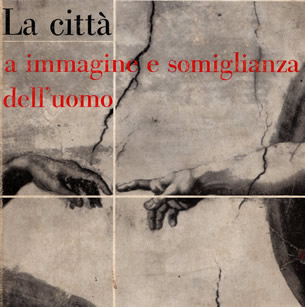Project for Milan and Lumbardy
by
VITTORIO MAZZUCCONI
Piano urbanistico per Milano, 1967
| BACK | HOMEPAGE | ARCHITECTURE | PAINTING | PHILOSOPHY | FOUNDATION |
| B.1.2.B1 |
| MEDIOLANUM Project for Milan and Lumbardy by VITTORIO MAZZUCCONI |
The City
In the Image and Resemblance of Man
(1/6) Piano urbanistico per Milano, 1967 |
| Index
MEDIOLANUM projects |

Vittorio Mazzucconi
|
First part The book starts with the image of a tree, not only because its trunk, viewed in section, makes us think of a radial-concentric city, but also because the tree is the profound symbol of all life processes, even in a transcendent sense. The first picture of the book is taken from Giotto: Saint Francis who stands in front of a tree and preaches to the birds. Of course this cannot be regarded as a town-planning approach, in a technical sense, while it is truly global, holistic. It‘s easy to see in the painting an anticipation of our love for nature and the concern today for the safeguard of the planet, but it is less easy although richer to understand all the marvellous meanings, which the tree suggests.We have seen that an obvious one, concerning our study, is the shape of the radial-concentric city, which is organic as a plant, the medieval cities being an example of it. But a further meaning is to be understood as a thought regarding the trunk. In our civilisation, it becomes the prototype column: a symbol of rationality, of harmony, which makes us think of the classical city. Organicity and rationality are therefore related as these two kinds of city, as are sentiment and intellect, the night and the day, nature and civilisation, and many other aspects of the dualistic world. At this point, the civilisation itself shows the same alternation between rational or “shining” periods and other more obscure ones, evolving with an organic elaboration, as we can see in both classical and medieval civilisation. The book follows the stages of this development till the European city of the last centuries and impacts on our present drama. In such a context, an experience seems to be crucial for us: the fall of the Roman Empire. This can be considered as the death of a civilisation from which has followed the birth of a new one, arriving to the present day. We face the same drama: the death of our civilisation, the birth of a new one, the suffering, the confusion, the conflicts that necessarily accompany such a passage. Therefore, if we wish to think about a new city, as the expression of a new civilisation, we must develop an approach able to go beyond the present circumstances, studying the history which has preceded ourselves, and in parallel develop a knowledge of human nature, in order to extract from that basis a generating impulse for our feelings, thoughts and actions on the city. In that way, we attain a harmony between sentiment and reason - or, if we wish to call it differently, between the heart and the mind - that has been lost in our time. Sentiment has degenerated in an unbridled mix of libido, emotions, destructive impulses, while reason |